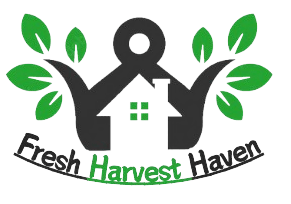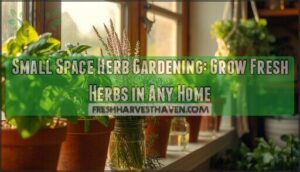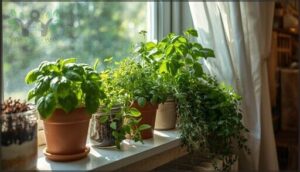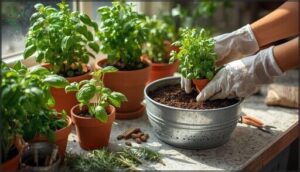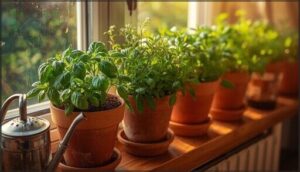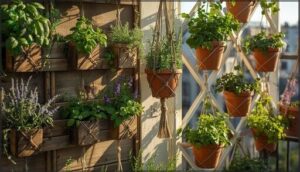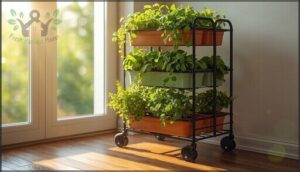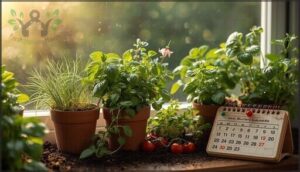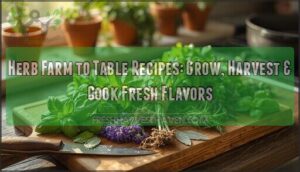This site is supported by our readers. We may earn a commission, at no cost to you, if you purchase through links.
Picture a windowsill lined with vibrant basil, a hanging basket of cascading thyme, or a vertical tower bursting with fresh parsley—all thriving in spaces no bigger than a bookshelf. Small space herb gardening transforms the tightest corners into productive gardens that deliver restaurant-quality flavors year-round.
Whether you rent a studio apartment or simply lack a backyard, containers and creative design reveal the same growing potential as sprawling plots. The secret lies in choosing compact varieties, optimizing vertical real estate, and matching each herb to the right growing conditions. With the proper setup, you’ll harvest generous amounts of aromatic herbs while spending less than ten minutes a day on maintenance.
Table Of Contents
- Key Takeaways
- Benefits of Small Space Herb Gardening
- Choosing Herbs for Limited Spaces
- Selecting and Preparing Containers
- Creating The Perfect Soil and Light Conditions
- Space-Saving Herb Garden Design Ideas
- Frequently Asked Questions (FAQs)
- How to grow herbs in a small space?
- What herbs are good for small gardens?
- What herbs should not grow together?
- What is the best layout for an herb garden?
- How much space does each herb need?
- Can I grow herbs from supermarket cuttings and scraps?
- How do pests affect indoor vs outdoor herbs?
- Which herbs can survive winter on a balcony?
- Are hydroponic systems worth it for small herbs?
- When should herbs be replaced with new plants?
- Conclusion
Key Takeaways
- You can grow restaurant-quality herbs in spaces as small as a windowsill by using compact varieties, vertical arrangements, and containers sized to each plant’s root depth—transforming even studio apartments into productive year-round gardens.
- Fresh herbs harvested seconds before cooking contain 30% more essential oils than dried versions and can cut your grocery costs by $75–$150 annually while reducing your carbon footprint by 80%.
- Success hinges on matching herbs to available light—sun-lovers like rosemary need 6+ hours of direct light daily, while shade-tolerant options like parsley and mint thrive with just 2–4 hours, making them perfect for darker corners.
- Vertical gardening and multi-tiered mobile containers can increase your growing area by 300% and boost yields by up to 40% in the same footprint, with proper soil drainage and strategic succession planting delivering continuous harvests from just six square feet.
Benefits of Small Space Herb Gardening
Growing herbs in small spaces isn’t just about saving room—it’s about bringing fresh flavor, practicality, and a bit of green life into your home. You’ll find that even a windowsill can become a productive garden that cuts costs and adds satisfaction to your cooking.
Let’s look at three reasons why small space herb gardening makes sense for your lifestyle.
Fresh Flavors and Aromas at Home
Nothing compares to the flavor intensity of fresh herbs snipped seconds before seasoning your meal. Growing herbs indoors brings aromatic benefits that transform your cooking space while giving you year-round access to better nutrition value. Fresh basil delivers 30% more essential oils than dried versions, and your small space herb garden unlocks culinary creativity through container gardening that keeps diverse flavors within arm’s reach.
Fresh herbs snipped seconds before cooking deliver unmatched flavor intensity and transform your kitchen into a year-round source of culinary creativity
Many find that using herb garden kits simplifies the process.
Low-Maintenance and Space Efficiency
Beyond great taste, small space gardening delivers surprising convenience. Compact herbs like chives thrive in containers just 6–8 inches wide, while vertical gardens convert minimal floor space into productive growing area.
You’ll spend under 30 minutes weekly maintaining low-maintenance herbs, and automated systems cut daily tasks to five minutes. Self-watering planters reduce watering frequency by 75%, making container gardening remarkably efficient for busy schedules.
Planters with integrated drainage systems improve water usage and prevent overwatering.
Health, Cost, and Sustainability Advantages
Small spaces deliver more than convenience—they’re a gateway to healthier eating. Home-grown herbs boost vegetable intake by 37% and contain up to 60% more antioxidants than store-bought options.
Your kitchen garden cuts grocery costs by $75–$150 yearly while slashing your carbon footprint by 80%. Container cultivation reduces toxin exposure by 45% and strengthens food security through year-round fresh herbs.
Choosing Herbs for Limited Spaces
Not every herb will thrive in a tight spot, but plenty will surprise you with their adaptability. The key is matching the right plant to your specific conditions—light levels, container size, and how much attention you can give.
Here’s a breakdown of the best herb types for small-scale growing and what makes each one work.
Best Herbs for Containers and Indoors
When you’re building a kitchen garden indoors, choosing the right herb varieties can mean the difference between thriving plants and disappointment. These five stand out for containers and small spaces:
- Basil: Harvest 60–90 grams per cycle with 6–8 hours of light; needs 15 cm-deep pots
- Parsley varieties: Produce 45 grams monthly in 8-inch containers
- Mint: Grows 3.1 cm weekly; containers prevent invasiveness by 70%
- Thyme: 85–92% survival rate in pots
- Oregano: Delivers 40 grams per season with direct sunlight
Sun-Loving Vs. Shade-Tolerant Varieties
When matching herb varieties to your available light, understanding sunlight requirements makes all the difference. Sun-loving herbs like rosemary, thyme, and sage need at least 6 hours of direct light daily to develop essential oils and intense flavor.
Shade-tolerant options—parsley, chives, cilantro, and mint—thrive with just 2–4 hours, making them perfect for north-facing windows or darker corners in small spaces.
Annuals, Perennials, and Dwarf Varieties
Annuals like basil and cilantro deliver quick harvests—up to 1.5 pounds per plant annually—but require succession planting every 3–4 weeks for a continuous supply. Dwarf varieties like ‘Spicy Globe’ basil fit six-inch pots perfectly, while vertical stacking increases yields by 18–32% in small spaces.
Perennials such as thyme and chives stay productive for 3–6 years in containers, reducing replanting effort by 40%.
Selecting and Preparing Containers
Choosing the right container sets the foundation for healthy herb growth in any small space. Your container needs to match your herb’s root depth, drainage requirements, and long-term growth habits.
Let’s look at the key factors that’ll help you select and prep containers for a thriving herb garden.
Ideal Container Sizes and Depths
Your herb garden’s success hinges on matching container size to root depth requirements. Most annual herbs like basil thrive in containers with 6–8 inches of soil depth, while perennials such as rosemary need 10–12 inches minimum.
Plan for one gallon of potting mix per plant—a 12-inch pot holds about 3–4 herbs comfortably. Proper volume per plant ensures adequate drainage considerations and prevents overcrowding in small spaces.
Material Options: Steel, Terracotta, Fabric, and More
Your container choice shapes how often you’ll water and how long your garden lasts. Consider these four popular materials for container gardening:
- Steel Durability – Galvanized options last over 10 years but heat soil quickly
- Terracotta Porosity – Classic terracotta pots dry 25% faster, reducing root rot risk
- Fabric Aeration – Grow bags boost root health by 32%, perfect for small spaces
- Plastic Affordability – Lightweight, budget-friendly, lasts 5–7 years
Match materials to your watering style when choosing herb containers.
Ensuring Drainage and Preventing Root Rot
Poor drainage kills more herbs than anything else. Your container needs drainage holes spaced every 3–4 inches to prevent waterlogged soil. Add a 2–4 cm gravel layer at the bottom for rapid water management strategies.
Use well-draining potting mix amended with compost—it improves soil drainage by 20–30% and strengthens root systems against rot.
Test moisture before watering to avoid oversaturation.
Labeling and Organizing Herb Containers
Ever notice how a well-organized herb garden feels like a chef’s spice rack? Label Material matters—laminated tags last through humidity, while accurate labeling frequency (every three months) keeps your Organization System sharp.
Effective labeling boosts harvest speed, prevents mix-ups, and fosters plant health. In small space gardening, container gardening thrives when Label Efficacy and smart organization protect herbs and elevate your Impact on Health.
Creating The Perfect Soil and Light Conditions
Now that your containers are ready, it’s time to focus on what goes inside them and where you’ll place them. Your herbs need the right soil blend, enough light exposure, and a watering routine that matches their natural preferences.
Let’s break down each element so your small-space garden can thrive from the start.
Well-Draining Soil Mixes and Amendments
Your soil mix makes or breaks your herb garden. You’ll want well-draining soil with 30–50% perlite or vermiculite blended in.
A 2:1:1 ratio—potting soil, perlite, and compost—gives herbs the drainage they need while organic amendments like vermicompost boost nutrient dynamics by up to 62%.
Add a 2–3 cm drainage layer in your container setup to prevent waterlogged roots and guarantee proper soil quality.
Optimizing Sunlight and Using Grow Lights
Now that you’ve got your soil right, providing adequate sunlight becomes your next priority. Most herbs need 6 hours of direct light daily, and southern windows deliver the best intensity. If natural light falls short, using grow lights effectively fills the gap. Here’s what you need to know about sunlight and herb growth:
- Light Intensity: High-yielding herbs like basil require 2000–3000 foot-candles, while mint thrives at 1000–1500 foot-candles.
- Spectrum Control: Full-spectrum LED grow lights replicate natural sunlight and support all growth stages year-round.
- Artificial Duration: Run your grow light 14–16 hours daily for light-loving herbs grown entirely indoors.
- LED Suitability: Position LEDs 6–12 inches above your herbs and use timers for consistent exposure.
Rotate containers every 3–4 days so plants don’t lean toward the light source. Light arrangement matters—placing grow lights directly overhead ensures uniform coverage and prevents leggy growth.
Matching Watering to Herb Needs
Light alone won’t keep your herbs thriving—watering techniques for herbs make or break your garden. Different species demand different watering schedules, and matching soil moisture to each plant’s needs prevents the twin pitfalls of over/under watering. Here’s your quick reference:
| Herb Type | Watering Frequency | Soil Moisture Level |
|---|---|---|
| Basil, Mint | Once weekly (deep) | Consistently moist |
| Parsley | 1-2 times weekly | Moist 2 inches down |
| Rosemary, Thyme | Every 10-15 days | Dry between waterings |
Self-watering systems cut water use by 50% while maintaining ideal conditions. They’re especially valuable for container-grown herbs, which dry 20% faster than ground plantings.
Check soil drainage before watering herbs effectively—stick your finger 2 inches deep. Dry? Water thoroughly. Still moist? Wait another day.
Seasonal adjustments matter too. Summer heat increases watering frequency by 40%, while cooler months let you stretch intervals. Over watering basil causes root rot in 60% of cases, so when in doubt, underwater Mediterranean varieties like rosemary and sage—they’ll forgive you.
Space-Saving Herb Garden Design Ideas
When floor space is scarce, the key to a thriving herb garden is thinking upward and outward. You can transform walls, railings, and underused corners into productive growing areas with the right setup.
Let’s explore practical ways to arrange your herbs so every inch works harder for you.
Vertical Gardens and Hanging Baskets
When floor space runs out, think upward. Vertical gardening and hanging baskets transform walls and railings into productive growing areas, using up to 99% less land than traditional plots. Here’s why they work:
- Water efficiency: Vertical setups can cut water use by 98% with drip irrigation.
- Enhanced air circulation: Hanging baskets reduce fungal diseases in herbs like basil and thyme.
- Temperature control: Green walls lower surrounding temps by up to 2.65°C, creating better microclimates for shade-tolerant varieties like parsley.
Mobile and Multi-Tiered Herb Gardens
Wheels change everything in small space gardening. Mobile, multi-tiered containers let you chase sunlight throughout the day, boosting yields by up to 30% and extending basil and cilantro lifespans by 40%.
A 4-foot vertical mobile bed delivers 10 lineal feet of growing space using just 6 square feet of floor area. You can stack up to four tiers, fitting ten herb varieties in one compact structure.
Succession Planting and Companion Planting Strategies
When you practice succession planting, you sow fresh seeds every two weeks, stretching harvests up to 35% beyond single plantings. Companion planting herbs—like basil with tomatoes or chives near parsley—cuts pest pressure by 68% while boosting aromatic compounds.
Smart spacing strategies and interplanting tall with trailing varieties make the most of vertical planes.
These small space gardening tips, paired with management planning that tracks planting intervals, transform six square feet into a continuously productive patch.
Maximizing Yield in Small Spaces
By interplanting compatible herb varieties and practicing succession planting, you’ll multiply harvests without expanding your footprint. Vertical gardening boosts growing area by 300%, while high-density planting in well-draining mixes increases yields up to 40%.
Light optimization—whether natural sun or LED supplementation—drives 60% more leaf production. Sequential harvesting of fast annuals like cilantro delivers five separate cuts per season, turning maximizing small space gardens into a continuous, flavorful reality.
Frequently Asked Questions (FAQs)
How to grow herbs in a small space?
Think container herb gardening is difficult? Start with proper herb selection, ensuring well-draining soil conditions and adequate lighting needs.
Vertical herb gardening and space optimization techniques can transform balcony herb gardens into productive harvests.
What herbs are good for small gardens?
Basil, chives, parsley, and thyme are container-friendly herbs perfect for compact spaces. Mint thrives in pots, while dwarf varieties of rosemary stay manageable. These low-maintenance herbs deliver high yields without demanding much room.
What herbs should not grow together?
Herb companion planting sounds romantic, but some pairings bomb spectacularly. Fennel’s notorious for growth suppression—keeping it near cilantro tanks biomass by 25%. Dill invites pests that wreck sage and marjoram.
Allelopathic herbs like wormwood sabotage neighbors through soil interactions.
What is the best layout for an herb garden?
Arrange herbs by height—shortest in front, tallest in back—using one plant per square foot.
Group them in clusters of three for symmetrical planting that balances visual appeal with efficient harvesting in compact layouts.
How much space does each herb need?
Proper plant spacing prevents root competition and maximizes yield correlation in containers. Compact herbs like chives need 6–8 inches, while mint containment requires isolation in 12-inch pots to prevent aggressive spreading.
Can I grow herbs from supermarket cuttings and scraps?
Yes, you can regrow fresh herbs from store-bought cuttings. Basil and mint show rooting success rates up to 95%, often sprouting roots within seven to fourteen days in clean water with indirect light.
How do pests affect indoor vs outdoor herbs?
Indoor plants face spider mites, aphids, and fungus gnats year-round, with 70% of growers reporting infestations annually.
Outdoor pest challenges include flea beetles and caterpillars, though natural predators provide better pest control and reduce disease transmission naturally.
Which herbs can survive winter on a balcony?
While tender basil won’t survive a freeze, cold-hardy herbs like chives, thyme, oregano, and sage thrive in balcony containers through winter—especially when you use proper overwintering techniques and select winter-tolerant container materials.
Are hydroponic systems worth it for small herbs?
Hydroponic systems for herbs offer impressive water efficiency and yield comparison benefits, but weigh energy consumption and hydroponic cost against your goals.
Consumer perception favors taste and sustainability, making them worthwhile for committed urban growers.
When should herbs be replaced with new plants?
Like a well-loved kitchen knife that eventually dulls, herb plants signal replacement time through yellowing leaves, stunted growth, or yield drops exceeding 30%.
These lifespan indicators reveal a productivity decline, demanding seasonal maintenance for optimal herb garden health.
Conclusion
The theory that great gardens require sprawling acreage crumbles under the weight of a thriving windowsill harvest. Small space herb gardening proves that square footage never dictates flavor—only ingenuity does.
You’ve learned to transform vertical walls into productive real estate, match herbs to microclimates, and coax restaurant-quality abundance from containers. Your compact setup now delivers fresh basil, thyme, and parsley whenever inspiration strikes.
The smallest gardens often yield the biggest culinary victories.
- https://www.seattletimes.com/life/food-drink/millennials-and-gen-z-lead-the-herb-garden-revival/
- https://www.statcan.gc.ca/o1/en/plus/5993-herb-your-enthusiasm
- https://www.grandviewresearch.com/industry-analysis/us-hydroponics-market-report
- https://www.lsuagcenter.com/articles/page1717696392923
- https://www.johnnyseeds.com/growers-library/herbs/herb-farming/herbs-container-production-tips.html
